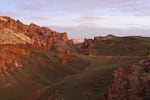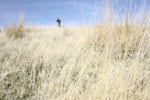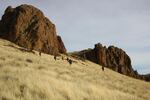
Residents and conservationists disagree over what should be done to protect the Owyhee region in southeastern Oregon.
Amanda Peacher / OPB
Last year, conservationists made a big push to convince President Obama to create a national monument in a vast area in Southeast Oregon known as the Owyhee.
It's a vast, rugged sagebrush steppe landscape with red rock canyons and unusual geology. But the proposal faced fierce resistance from ranchers and other locals in Malheur County. At the end of his term, the Owyhee was left off of Obama’s list of new and expanded monuments.
Related: Ranchers And Loggers Dismayed At Cascade-Siskiyou Monument Expansion
But the specter of a monument designation may trigger groups on opposite sides to get together and start a collaborative plan for the Owyhee. Tim Davis, with the grassroots conservation group called Friends of the Owyhee, said he believes it's possible to work with groups that opposed the monument.
"If it was a collaborative effort I think they'd be would be willing to sit down at the table and work it out," he said. "There are areas that both sides can agree on for protection. Jordan Craters, for example. It’s a big lava field. Why not start there?"
This wouldn't be the first time that a potential presidential designation has spurred monument opponents to come to the table. On the Idaho side of the Owyhee, the possibility of a national monument designation by President Bill Clinton kick-started a decades-long collaborative process between conservationists, off-road vehicle groups, ranchers and the government. The effort led to new wilderness and wild and scenic river designations in 2009.
A similar process led to the Steens Mountain Cooperative Management and Protection Area in southeast Oregon in 2000. And more recently, the possibility of an Obama designation in Central Idaho led to the hastening of a Republican-championed wilderness area for the Boulder White Clouds mountains.
But there's no exact formula for getting diverse groups together in the wake of such proposals.
"Each place is unique," said Brent Fenty, executive director of the Oregon Natural Desert Association. ONDA has been talking about wilderness designations for the Owyhee for more than a decade, and Fenty said his group plans to hold town hall meetings across the state to further the conversation.
"That’s what we’re focused on — continuing that dialogue to ensure that the people who know and love this place have their voices heard," Fenty said.
Although there's no official collaborative process in the works yet, groups that opposed the monument have hinted that they'd be willing to have such conversations.
"We're still kind of in awe that we made it past the national monument designation," said Malheur County rancher Elias Eiguren, a spokesman for the Owyhee Basin Stewardship Coalition. But with the threat of a monument behind them, he and other ranchers have been busy with calving season.
"Spring work is hitting us in the face," Eiguren said. "We're trying to just hold together at this point and really decide where we need to go from here."

Cheatgrass dominates the landscape in the Owyhee. The invasive species is a problem in much of Eastern Oregon.
Amanda Peacher / OPB
Eiguren said he's yet to see a federal designation that improved a landscape. He'd like to focus on what he sees as the biggest threats to the Owyhee: invasive weeds and major wildfires. But he wouldn't necessarily try to block a wilderness designation, depending on the circumstances. He said that any collaborative process would need to start with assurances from environmental groups that litigation is off the table.
"I don’t know that a wilderness designation wouldn’t necessarily change what is out there already so I wouldn’t necessarily understand the purpose of that," he said. "But if somebody had to have that, there’s always that possibility."



